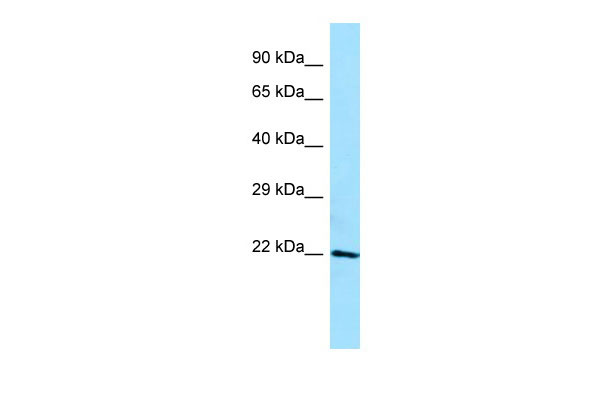APOM antibody - C-terminal region
Rabbit Polyclonal Antibody
- SPECIFICATION
- CITATIONS: 1
- PROTOCOLS
- BACKGROUND

Application
| WB |
|---|---|
| Primary Accession | O95445 |
| Other Accession | NM_019101, NP_061974 |
| Reactivity | Human, Mouse, Rat, Rabbit, Pig, Horse, Bovine, Guinea Pig, Dog |
| Predicted | Human, Mouse, Rat, Pig, Bovine, Guinea Pig, Dog |
| Host | Rabbit |
| Clonality | Polyclonal |
| Calculated MW | 21kDa |
| Gene ID | 55937 |
|---|---|
| Alias Symbol | G3a, HSPC336, MGC22400, NG20, apo-M |
| Other Names | Apolipoprotein M, Apo-M, ApoM, Protein G3a, APOM, G3A, NG20 |
| Format | Liquid. Purified antibody supplied in 1x PBS buffer with 0.09% (w/v) sodium azide and 2% sucrose. |
| Reconstitution & Storage | Add 50 ul of distilled water. Final anti-APOM antibody concentration is 1 mg/ml in PBS buffer with 2% sucrose. For longer periods of storage, store at 20°C. Avoid repeat freeze-thaw cycles. |
| Precautions | APOM antibody - C-terminal region is for research use only and not for use in diagnostic or therapeutic procedures. |
| Name | APOM |
|---|---|
| Synonyms | G3A, NG20 |
| Function | Probably involved in lipid transport. Can bind sphingosine-1- phosphate, myristic acid, palmitic acid and stearic acid, retinol, all- trans-retinoic acid and 9-cis-retinoic acid. |
| Cellular Location | Secreted. Note=Present in high density lipoprotein (HDL) and to a lesser extent in triglyceride-rich lipoproteins (TGRLP) and low density lipoproteins (LDL) |
| Tissue Location | Plasma protein. Expressed in liver and kidney. |

Provided below are standard protocols that you may find useful for product applications.
References
Xu N.,et al.J. Biol. Chem. 274:31286-31290(1999).
Thomson W.,et al.Submitted (JUL-1999) to the EMBL/GenBank/DDBJ databases.
Ye M.,et al.Submitted (MAY-1999) to the EMBL/GenBank/DDBJ databases.
Shiina S.,et al.Submitted (SEP-1999) to the EMBL/GenBank/DDBJ databases.
Xie T.,et al.Genome Res. 13:2621-2636(2003).
If you have used an Abcepta product and would like to share how it has performed, please click on the "Submit Review" button and provide the requested information. Our staff will examine and post your review and contact you if needed.
If you have any additional inquiries please email technical services at tech@abcepta.com.














 Foundational characteristics of cancer include proliferation, angiogenesis, migration, evasion of apoptosis, and cellular immortality. Find key markers for these cellular processes and antibodies to detect them.
Foundational characteristics of cancer include proliferation, angiogenesis, migration, evasion of apoptosis, and cellular immortality. Find key markers for these cellular processes and antibodies to detect them. The SUMOplot™ Analysis Program predicts and scores sumoylation sites in your protein. SUMOylation is a post-translational modification involved in various cellular processes, such as nuclear-cytosolic transport, transcriptional regulation, apoptosis, protein stability, response to stress, and progression through the cell cycle.
The SUMOplot™ Analysis Program predicts and scores sumoylation sites in your protein. SUMOylation is a post-translational modification involved in various cellular processes, such as nuclear-cytosolic transport, transcriptional regulation, apoptosis, protein stability, response to stress, and progression through the cell cycle. The Autophagy Receptor Motif Plotter predicts and scores autophagy receptor binding sites in your protein. Identifying proteins connected to this pathway is critical to understanding the role of autophagy in physiological as well as pathological processes such as development, differentiation, neurodegenerative diseases, stress, infection, and cancer.
The Autophagy Receptor Motif Plotter predicts and scores autophagy receptor binding sites in your protein. Identifying proteins connected to this pathway is critical to understanding the role of autophagy in physiological as well as pathological processes such as development, differentiation, neurodegenerative diseases, stress, infection, and cancer.

